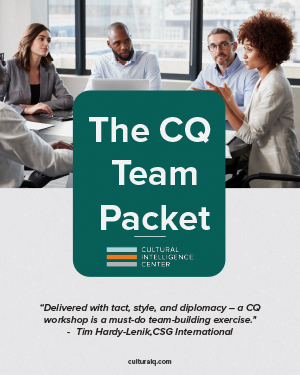It’s widely known that Amazon founder, Jeff Bezos, frequently leaves one open seat at the company’s most important meetings. It’s there to remind his fellow executives and managers of the most important person in the room—the customer.
Forbes reports that Amazon tracks its performance against five hundred measurable goals. Nearly 80 percent relate to customer objectives.
But if the people at the meeting don’t have cultural intelligence, it’s unlikely the chair will be of much benefit. The participants will simply assume the person represented by the empty chair values what they do. And if everyone in the meeting comes from the same cultural background, it’s going to be tough to get a grasp of preferences and opinions of the customer.
So go ahead and add an empty chair to your most important meetings. But don’t stop with that. To make the most of this creative practice, follow these “empty chair” guidelines:
1. Break the Golden Rule: Remind everyone in the meeting that their own values and perspectives can’t be applied to all customers. Treating everyone with kindness and respect is an aspect of the Golden Rule we can all embrace. But there are a thousand different interpretations of what kindness and respect look like, largely shaped by one’s cultural background. It’s an elementary point, but one that is quickly forgotten: Don’t assume everyone wants what you want.
2. Focus: Most of our organizations aren’t trying to become the earth’s largest retail machine (a.k.a. Amazon). So who is the primary target related to today’s conversation? Who isn’t? How much do you know about them? The days of mass marketing are long over. Every choice is a renunciation. To focus on one type of customer is to renounce a thousand others. What are the specific needs and desires of this target audience and how will today’s agenda address those?
3. Perspective-Taking: The empty chair assumes people in the meeting are adept at perspective-taking: the ability to step outside their own experience and imagine the perceptions and motivations of another. This means being able to predict:
- What does our customer (or prospective customer) value?
- What’s going on in her mind?
- What would she say about the ideas we’re discussing right now?
As you improve CQ Knowledge—an understanding of how culture influences the way people think and behave—your team can more accurately predict the perspective of culturally diverse customers. And this understanding needs to be based upon empirical research. Avoid letting meeting participants describe the behaviors of all teenagers based upon their child’s behavior or declaring what Indian women think based upon what their friend is like. What does research reveal about the dominant norms among these various subcultures?
4. Adjust Perspectives: Make this a dynamic, ongoing process. Based upon further observations, emerging trends, and real-life interactions with customers, move beyond broad assumptions to more specific insights about your target group. Norms about Hispanic men, Chinese-American women, or millennials provide a good hypothesis for predicting what these customers will want. But be open to adapting those insights. And find ways to fill the chair with live customers from time-to-time to get their first hand input.
The obsession to understand the customer gives Amazon the confidence to innovate freely without fretting about short-term results. Bezos says. “We don’t focus on the optics of the next quarter; we focus on what is going to be good for customers.”
Without cultural intelligence, there’s little benefit from adopting this Amazon practice. But an empty chair + cultural intelligence is a smart, strategic way to keep your meetings focused on the most important people your organization exists to serve.
